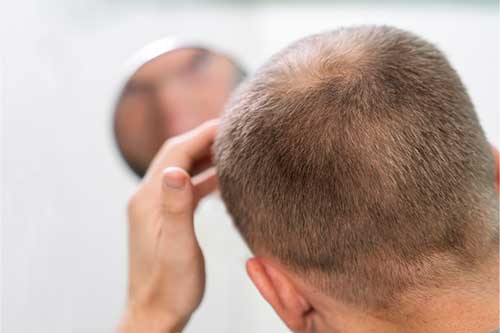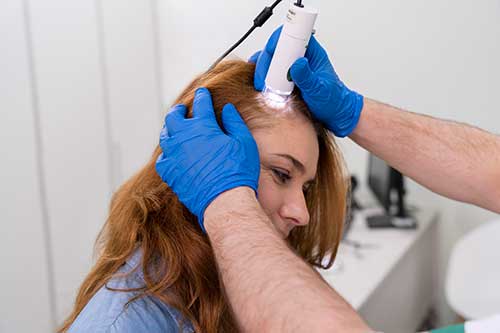
Hair Thinning vs Hair Loss – The Difference Explained
 Hair thinning and hair loss are terms that might seem similar, but they are not. They are very much different. Hair loss is a much-advanced stage of hair thinning. This blog article will discuss the difference between the two – hair thinning and hair loss.
Hair thinning and hair loss are terms that might seem similar, but they are not. They are very much different. Hair loss is a much-advanced stage of hair thinning. This blog article will discuss the difference between the two – hair thinning and hair loss.
As claimed by many, losing 50 to 100 strands of hair every day is normal. However, if you experience a sudden loss of density in your hair, it means your hair is thinning, and you are experiencing hair loss. Hair thinning and hair loss are two different occurrences. However, in many cases, hair thinning can lead to hair loss that can result in balding or complete loss of hair on your head. In this blog, we will discuss both hair loss and hair thinning, the differences between them, as well as treatments that are available for hair thinning and hair loss. Keep reading!
What is Hair Thinning?
Hair thinning is a condition in which the hair shaft starts growing thinner in diameter with each hair fall and regrowth cycle. As the diameter of the hair shaft becomes thinner, the hair that grows out of it grows thinner too. Hair thinning is a slow process and happens over a considerably long period of time.
Hair thinning is seen in individuals as they grow older. You can tell that your hair is thinning if you notice your partition widening or if you are losing the density of your hair. If you find your hair thinning and it concerns you, consult your trichologist or dermatologist immediately.
Causes of Hair Thinning
There are not many factors that cause thinning of hair. What is noteworthy is that the factors that cause hair thinning can lead to hair loss as well. The 2 most common reasons behind hair thinning are:
- Old age: One of the main reasons for hair thinning is old age. In many individuals, as they age, their hair follicles or shafts begin to become weak and grow thinner (as discussed earlier). The effect is a drop in the density of hair. This can, in time, lead to hair loss, resulting in balding in most people. Thinning due to old age is common in both men and women but apparent in women. Women start to notice their hair thinning from when they turn 40 and experience a considerable amount of hair ‘loss’ within that decade.
- Hormonal conditions: Hair thinning due to hormonal changes that leads to hair loss is commonly called androgenic alopecia. When androgen levels are high in your body’s composition, you will experience thinning of hair and subsequently hair loss too. Androgen is the male sex hormone that is present predominantly in males, but all females also carry this hormone. When the percentage of this hormone shoots up, it becomes one of the reasons for hormone imbalance. Conditions like PCOD/PCOD, thyroid, pregnancy, menopause, etc., involve hormonal changes (in women) and can lead to hair thinning.
Apart from these two major contributors to hair thinning, the lack of vitamins and minerals in the body can also cause the hair to thin out. In this regard, zinc deficiency and vitamin D deficiency usually lead to hair thinning in individuals.
Before we move on to discuss the difference between hair thinning and the resultant hair loss, let’s define hair loss in the next section.
 What is Hair Loss?
What is Hair Loss?
Hair loss is the process of losing abnormal amounts of hair in patches on the head. As discussed earlier, hair loss can lead to balding or complete loss of hair. Hair loss is an extremely common condition experienced by a major chunk of the world’s population. Hair loss has a direct impact on the individual’s self-confidence, which takes a dip, especially in the case of balding. Hair loss can be gradual or sudden.
Either way, it is advisable for you to consult your doctor if you are experiencing loss of hair in abnormal quantities. You might find your hairline receding, bald patches around your head, and you might even find yourself drawing clumps of hair as your run your fingers through it. If you think you are losing abnormal amounts of hair, then visit your dermatologist or your trichologist to get it sorted.
Causes for hair loss in individuals
There are many causes of hair loss experienced by people. They include –
- Hereditary factors: Called androgenetic alopecia, this is hair loss experienced due to a family history of balding. It is also called male pattern baldness and female pattern baldness.
- Medical conditions: Hair loss can also be caused by medical conditions, treatments, and medicines prescribed. The most common example of this is hair loss which is a side effect for cancer patients due to the intake of heavy drugs and steroids in chemotherapy.
- Stress: Stress can cause hair follicles to go into shock and shut down for a while. This interrupts the hair growth cycle – hair shedding happens, but regrowth doesn’t – and causes bald patches. However, this problem is overcome once the individual overcomes stress.
These are some of the most common causes of hair loss. In addition to this, people experience hair loss and balding due to hormonal changes and also when they put their hair through frequent chemical treatments.
Now that we have defined what hair thinning and hair loss is let us move on to drawing a difference between the two. Stay with us!
The difference between hair thinning and hair loss
Hair thinning and hair loss are not entirely different things, but they are also not the same thing. Both hair thinning and hair loss concern the loss of hair. Let’s look at how different the two of these conditions are –
- Hair thinning is not hair fall. It is the drop in diameter of the hair as a result of the thinning of the hair shaft. On the other hand, hair loss causes hair to fall.
- Hair thinning lays the foundation for hair loss and balding. Hair thinning’s symptoms are almost similar to that of hair loss because it is the first sign of hair loss. At the same time, hair loss is never the cause of hair thinning.
- Hair thinning does not mean a stoppage of hair growth. It is a condition that slows down the hair growth process as a result of a lengthened gap between the telogen (shedding) and anagen (growing) phases of the hair cycle. Hair loss, on the other hand, is when the production of hair is interrupted and stopped altogether. This is when balding happens.
These are the basic differences between hair thinning and hair loss. Today, there are several treatments for both hair thinning and hair loss. If you are facing hair-related issues, head to NI’S TRICHOLOGY. We offer a wide range of treatments that will help you overcome the issues related to hair loss and hair thinning.[/vc_column_text][/vc_column][/vc_row]










